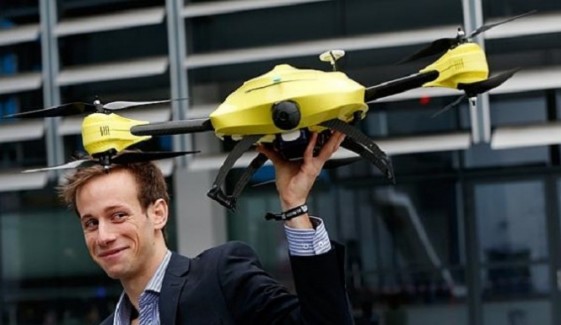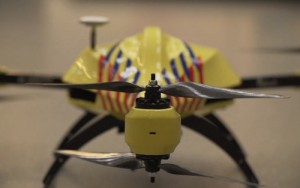
During an emergency involving the heart, each minute that the ambulance loses in reaching the victim drastically brings down the chances of survival. Now a Dutch-based engineering student has designed a life-saving drone that claims to significantly bring down response time.
 Each year nearly a million people in Europe suffer from a cardiac arrest. A mere 8% survives due to slow response times of emergency services. The ambulance-drone is capable of saving lives with an integrated defibrillator. The goal is to improve existing emergency infrastructure with a network of drones. This new type of drones can go over 100 km/h and reaches its destination within 1 minute, which increases chance of survival from 8% to 80%! This drone folds up and becomes a toolbox for all kind of emergency supplies. Future implementations will also serve other use cases such as drowning, diabetes, respiratory issues and traumas.
Each year nearly a million people in Europe suffer from a cardiac arrest. A mere 8% survives due to slow response times of emergency services. The ambulance-drone is capable of saving lives with an integrated defibrillator. The goal is to improve existing emergency infrastructure with a network of drones. This new type of drones can go over 100 km/h and reaches its destination within 1 minute, which increases chance of survival from 8% to 80%! This drone folds up and becomes a toolbox for all kind of emergency supplies. Future implementations will also serve other use cases such as drowning, diabetes, respiratory issues and traumas.
Belgian engineering graduate Alec Momont has designed and developed what he calls an “Ambulance Drone.” Essentially, it is an autonomous and unmanned miniature flying drone outfitted with a defibrillator, reported the Daily Mail.
The Ambulance Drone is an interesting take on medical assistance and response time reduction methodologies. While drones have been used for multiple purposes, ranging from aerial survey to photography to the delivery of couriered packages, this is the first time these self-maneuvering machines are being used to tend to medical emergencies.
Speaking about the need for such an innovation, 23-year-old Alec said, “Around 800,000 people suffer a cardiac arrest in the European Union every year and only 8 per cent survive. The main reason for this is the relatively long response time of emergency services of around 10 minutes, while brain death and fatalities occur within four to six minutes. The ambulance drone can get a defibrillator to a patient within a 12 square kilometer zone within a minute, increasing the chance of survival from 8 percent to 80 percent.”
 The Ambulance Drone is designed to track mobile calls made to the emergency number and zero-in on the same using standard GPS protocols. The drone is fitted with cameras, speakers, and a microphone so that the person who has made the call can listen to emergency medical personnel at the other end and follow simple instructions to revive and stabilize the victim.
The Ambulance Drone is designed to track mobile calls made to the emergency number and zero-in on the same using standard GPS protocols. The drone is fitted with cameras, speakers, and a microphone so that the person who has made the call can listen to emergency medical personnel at the other end and follow simple instructions to revive and stabilize the victim.
Painted in colors that are reserved for emergency response vehicles, these Ambulance Drones can carry a load of 4 kilograms, reported News. Though Alec’s drone has been designed to carry a defibrillator, the concept of using a drone to dispatch emergency medical supplies and equipment in a tight and difficult-to-drive urban environment can certainly mean the difference between life and death.
Apparently, the flying defibrillator is just the beginning, promises Alec. He wants his drone to become a “flying medical toolbox” able to carry an oxygen mask to a person trapped in a fire or an insulin injection to a diabetes sufferer.
Costing around $22,500 a piece, these flying robots are certainly cheaper than a fully-equipped ambulance and can be deployed at multiple strategic locations around cities, ready to fly out and reach where they are needed within a lot less time it takes an ambulance to get there.






